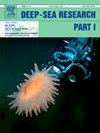深海的稳定联系:西北大西洋深海珊瑚Lophelia pertusa (=Desmophyllum pertusum)在时间上一致的幼虫途径
IF 2.1
3区 地球科学
Q2 OCEANOGRAPHY
Deep-Sea Research Part I-Oceanographic Research Papers
Pub Date : 2025-02-20
DOI:10.1016/j.dsr.2025.104462
引用次数: 0
摘要
种群连通性促进了遗传交换,增强了种群的复原力,促进了种群的长期持久性。对于无底栖无脊椎动物来说,幼虫的扩散是实现种群连通性的主要机制。在这里,我们使用幼虫扩散的生物物理模型来阐明种群之间的潜在联系并量化扩散途径,我们将其与网络理论分析相结合来评估它们对整个网络稳定性的潜在重要性。由于这些分析的必要参数难以量化,对于具有未解决的生活史特征的深海物种,我们使用一系列可能的生活史特征值探索多种场景。以西北大西洋北美深水珊瑚Lophelia pertusa (=Desmophyllum pertusum)为研究对象,我们使用高分辨率海洋环流模型结合幼虫参数,预测了2005年至2018年14年间每个季节的幼虫扩散情况。然后,我们使用幼虫扩散途径来识别种群之间的联系,并使用网络理论来揭示网络结构并量化每个种群对网络内整体连通性的重要性。幼虫滞留在北部地区和墨西哥湾地区最强,这表明这些种群可以在没有其他地区幼虫影响的情况下持续存在。两条主要的运输路径发生在墨西哥湾流从佛罗里达向北流向美国东部之后,以及拉布拉多洋流从加拿大专属经济区向西南移动之后,南北区域之间几乎没有交换。我们的网络理论分析表明,诺福克峡谷的L. pertusa种群主要负责南北种群之间的交流,没有向北的联系。我们基于种群连通性的社区检测分析与先前基于该地区遗传连通性估计的模式非常吻合。这是第一个分析西北大西洋L. pertusa潜在连通性的研究,并在整个产卵季节、年份和生物学参数中预测了主要连接途径的一致性。我们的结果在评估种群对人为干扰的易感性方面是不可或缺的,并且直接适用于我们研究领域内与模型范围内具有相似生活史特征的其他深海物种。本文章由计算机程序翻译,如有差异,请以英文原文为准。
Stable connections in the deep sea: Temporally consistent larval pathways for the deep-sea coral, Lophelia pertusa (=Desmophyllum pertusum) in the Northwest Atlantic Ocean
Population connectivity facilitates genetic exchange and increases resilience of populations promoting long-term persistence. For sessile benthic invertebrates, larval dispersal provides the main mechanism to achieving population connectivity. Here, we use biophysical modelling of larval dispersal to elucidate potential connections between populations and quantify dispersal pathways, which we combine with network-theoretic analyses to evaluate their potential importance to the stability of the entire network. Because the necessary parameters for these analyses are difficult to quantify for deep-sea species with unresolved life-history traits, we explore multiple scenarios using a range of likely life-history trait values. Focussing on the deep-water coral Lophelia pertusa (=Desmophyllum pertusum) over its North American range in the Northwest Atlantic Ocean, we used a high-resolution ocean circulation model in combination with larval parameters to project larval dispersal for each season over 14 years from 2005 to 2018. We then use the larval dispersal pathways to identify connections between populations, and network theory to uncover network structure and quantify the importance of each population to the overall connectivity within the network. Larval retention was strongest in the northern domain and within the Gulf of Mexico, suggesting these populations could persist without larval influence from other areas. The two dominant transport pathways occurred following the Gulf Stream from Florida north towards the eastern United States and following the Labrador Current travelling southwestwards from the Canadian EEZ with little exchange between northern and southern domains. Our network-theoretic analysis suggested that the populations of L. pertusa in Norfolk Canyon are primarily responsible for exchange between northern and southern populations, with no northward connections. Our community detection analysis based on population connectivity agrees well with previous patterns based on estimates of genetic connectivity in the area. This is the first study to analyse potential connectivity of L. pertusa in the NW Atlantic Ocean, and projects consistency in the dominant connection pathways throughout spawning seasons, years, and for biological parameters. Our results are integral in assessing a populations susceptibility to anthropogenic disturbance and are directly applicable to other deep-sea species in our domain with similar life-history traits to those within the modelled ranges.
求助全文
通过发布文献求助,成功后即可免费获取论文全文。
去求助
来源期刊
CiteScore
4.60
自引率
4.20%
发文量
144
审稿时长
18.3 weeks
期刊介绍:
Deep-Sea Research Part I: Oceanographic Research Papers is devoted to the publication of the results of original scientific research, including theoretical work of evident oceanographic applicability; and the solution of instrumental or methodological problems with evidence of successful use. The journal is distinguished by its interdisciplinary nature and its breadth, covering the geological, physical, chemical and biological aspects of the ocean and its boundaries with the sea floor and the atmosphere. In addition to regular "Research Papers" and "Instruments and Methods" papers, briefer communications may be published as "Notes". Supplemental matter, such as extensive data tables or graphs and multimedia content, may be published as electronic appendices.

 求助内容:
求助内容: 应助结果提醒方式:
应助结果提醒方式:


